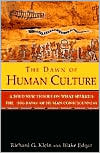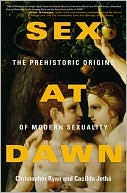Dawn of Human Culture
"The premier anthropologist in the country today."\ -Evolutionary Anthropology on Richard Klein\ "High above the western shore of Lake Naivasha, a blue pool on the parched floor of East Africa's Great Rift Valley, sits a small rockshelter carved into the Mau Escarpment. Maasai pastoralists who once occupied this region in central Kenya called the place Enkapune Ya Muto, or 'Twilight Cave.' People have long sought shelter there. The cave's sediments record important cultural changes during the...
Search in google:
The Dawn of Human CultureSome fifty thousand years ago Homo sapiens, the newest branch of a long and varied tree of evolved apes, suddenly developed a remarkable range of new talents. These people-whose primitive stone culture had previously been little different from that of their ancestors-began painting. They invented music and the instruments to play it. They fashioned jewelry and clothing, created fishing poles and tackle as well as bows and arrows, constructed the oldest substantial houses, and buried their dead with ritual and ceremony. This creative explosion, occurring over such a remarkably short period, has been called the "big bang" of human culture.It was the fourth in a series of punctuated events that have marked the history of human evolution. The first occurred between seven and five million years ago when a group of African apes, in response to shrinking forests and expanding open savannas, began to walk upright. These are the bipedal apes of which Lucy and her kin are the most famous. The next occurred about two and a half million years ago, again during a time of global climatic change resulting in major environmental disruption, when the first stone-tool makers emerged. The third occurred about 1.8 million years ago when humans developed modern body proportions and colonized largely treeless environments for the first time.So what accelerated our cultural development? What made us who we are?Now, for the first time, preeminent anthropologist Richard Klein tackles this mystery, one of the great enigmas of our evolution. With Blake Edgar, he works his way forward through time as Homo developed, looking for clues, discarding false leads, and examining why other species of man such as the Neanderthals failed to develop a similar culture-and failed to survive. He reexamines the archeological evidence, including the latest findings, and considers new discoveries in the study of human genetics. This journey leads him to a bold new theory involving the brain that could solve the mystery of our origins and that points the way for future studies. Booknews Written for the non-specialist, this fast-moving account provides a history of the development of humans and, more specifically, the human brain as this can be deduced from the earliest creations of art. Klein (anthropology, Stanford U.), with the assistance of Blake Edgar (science editor, U. of California Press), writes of the people and events that led to discoveries as well as the scientific studies and development of theories concerning the human brain. He then draws his own conclusions about the reasons for humans' unprecedented success as a species. Annotation c. Book News, Inc., Portland, OR (booknews.com)
Click to read or download
Preface7Chapter 1Dawn at Twilight Cave11Chapter 2Bipedal Apes29Chapter 3The World's Oldest Whodunit63Chapter 4The First True Humans91Chapter 5Humanity Branches Out133Chapter 6Neanderthals Out on a Limb169Chapter 7Body Before Behavior217Chapter 8Nurture or Nature Before the Dawn?257AppendixPlacing Ancient Sites in Time274Selected Further Reading278Index284
\ From the Publisher"...a compelling story...it's a tale worth reading..." (Focus, July 2002)\ \ \ \ \ Written for the non-specialist, this fast-moving account provides a history of the development of humans and, more specifically, the human brain as this can be deduced from the earliest creations of art. Klein (anthropology, Stanford U.), with the assistance of Blake Edgar (science editor, U. of California Press), writes of the people and events that led to discoveries as well as the scientific studies and development of theories concerning the human brain. He then draws his own conclusions about the reasons for humans' unprecedented success as a species. Annotation c. Book News, Inc., Portland, OR (booknews.com)\ \








